Tour de France: The French terms you need to know
- Published
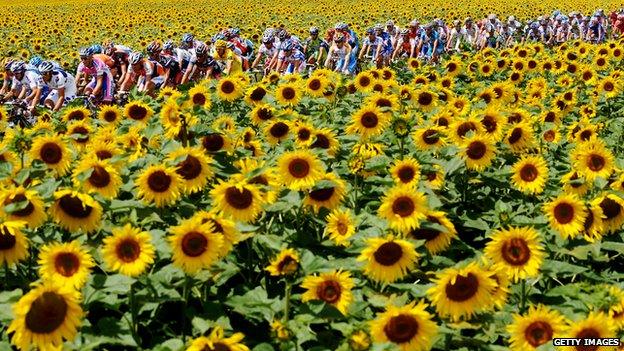
A classic Tour sight: The peloton rides through fields of sunflowers
The Tour de France, the annual cycling race that is part endurance sport, part three-week advertisement for the French countryside, is becoming more English-speaking, writes Catherine Wynne.
With an increasing number of Anglophone riders and journalists on the Tour, external, it is perhaps not surprising that English is becoming... yes, the lingua franca of the race.
But there are some French words which are such an important part of Le Tour that no cyclist - or self-respecting fan - could get by without them.
1. Peloton
Peloton refers to the main group of cyclists riding together during a stage. Literally translated as "little ball", the term was first used to refer to a small group of soldiers, who, like cyclists, travel in tight formation. The word "platoon" is thought to be a variation of peloton.
Cyclists travel together in packs for protection - mostly from the wind, as a rider uses about a third less energy by riding in another's slipstream.
2. Domestique
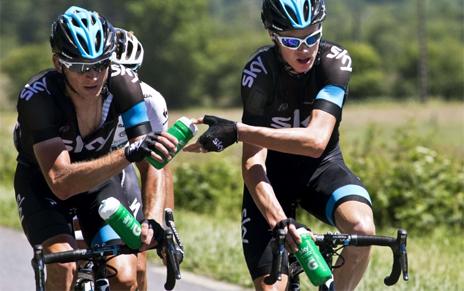
Chris Froome (right) gets water from domestique Kanstantsin Siutsou
Riders win the tour as individuals, but they would not be able to do it without their team mates. This year's Tour started with 22 teams of nine riders. Each has a designated leader - the VIP of the team - who is looked after by riders known as domestiques.
They are the foot soldiers of this small, travelling army. A domestique will turn up the pace to try to weaken rivals or defend his leader from attack. He will also be expected to fetch food and clothing from the team car - and give up his bike if his leader has a mechanical problem. Overall, the main aim is to save the leader as much energy as possible for the crucial moments of the race.
3. Hors categorie
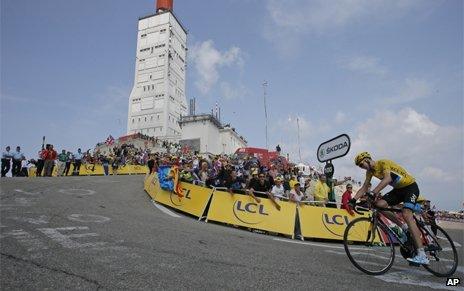
Those crucial moments often take place on steep mountain roads. This is where many Tours are won and lost.
Each mountain climb is ranked according to difficulty from four to one - but the most punishing are given the label "hors categorie", or beyond categorisation. Tour legend has it that the numbers originally referred to the gear that a car would have to be in to go up it. HC climbs, it is said, were either impassable by car or would even have to be tackled in reverse gear. Nice story, if true.
4. Flamme rouge
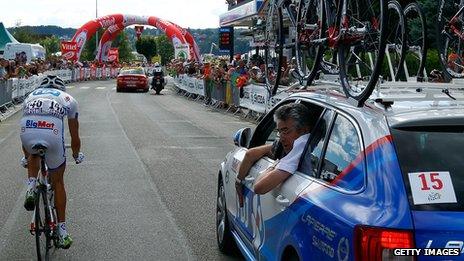
A welcome sight to all riders, the flamme rouge is a red flag which indicates there is 1km to go in that day's stage. It hangs from an inflatable arch over the road.
5. Lanterne rouge
The lanterne rouge is the name given to the rider who finishes the Tour in the longest time. Last year's last man, Frenchman Jimmy Engoulvent, rode the 3,494.4km course almost four hours slower than the winner, Bradley Wiggins.
Due to the publicity that comes with being the lanterne rouge, riders who have toiled as anonymous domestiques for three weeks have been known to ride more slowly towards the end to try to win the accolade. The term comes from the red light that used to hang at the back of trains so that drivers could see that none of the carriages had come loose.
6. Autobus
The lanterne rouge may often find himself riding in the autobus, or grupetto. This is the group of riders - typically star sprinters or hard-working domestiques - who cannot keep up with the best climbers on the punishing climbs through the Alps or the Pyrenees.
As the slower riders gradually drop off the pace, they gather together and ride to the finish in a group. It saves energy and is a way of keeping up morale, helping to ensure that they don't get eliminated for being too much slower than the average rider.
7. Musette
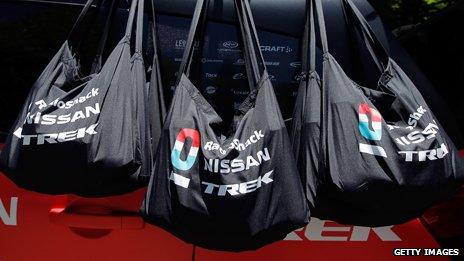
Musettes ready for the riders at last year's Tour
A musette is a rider's equivalent of a lunchbox. Part way through the stage cyclists will be handed a fabric bag by a team employee stationed by the side of the road. When the first British team rode the Tour de France in the 1950s, they were given bags containing a chunk of chicken and a handful of dried fruit. Today, riders are more likely to find high energy bars, small cakes and sandwiches in their musettes.
On the hotter days of the Tour de France, a team can also get through over 200 water bottles, or bidons, per day.
8. Soigneur
In the early days of the Tour, riders used metal bidons and stopped at village fountains to refill them. Now, filling up those hundreds of bottles a day and packing the musettes are part of the job of a team's soigneurs.
A soigneur is the non-cycling equivalent of a domestique. He or she makes sure that the riders sleep, eat and drink well and also gives the riders their daily massages.
9. Directeur sportif
Even English-speaking teams, tend to still refer to the boss as the directeur sportif. The DS is often a former professional rider and their office during the Tour is the team car. They decide on tactics and speak to the riders - and sometimes other teams' directeurs - about strategy. They can often be seen handing a bottle or shouting encouragement to a cyclist through the car window.
10. Chapeau
A wonderful French term which is frequently used by cyclists to indicate respect for another's achievements. By saying "chapeau", which literally means "hat", the rider is doffing his cap to a colleague for a good day's riding.
You can follow the Magazine on Twitter, external and on Facebook, external
- Attribution
- Published4 July 2014
